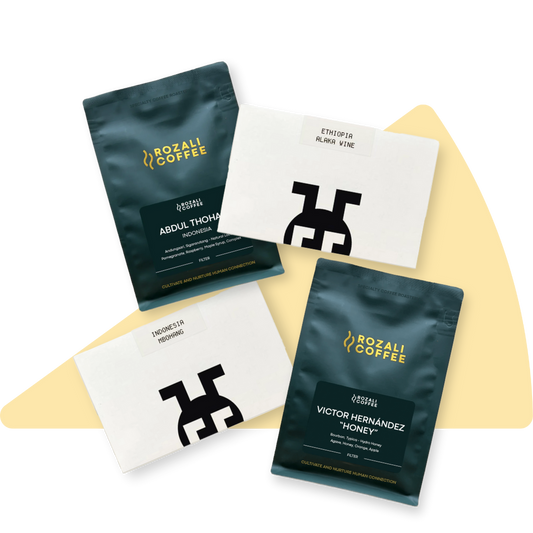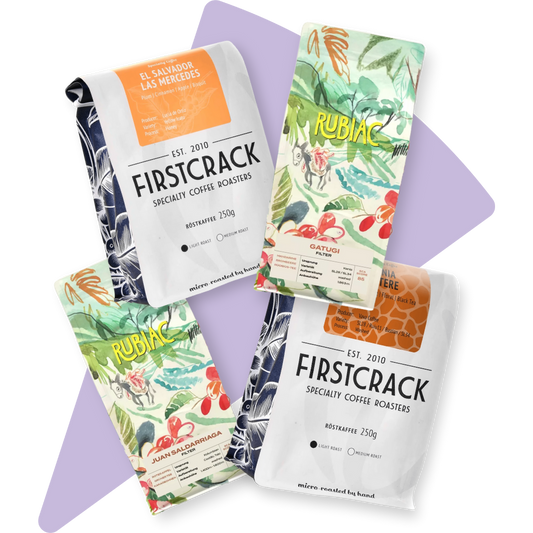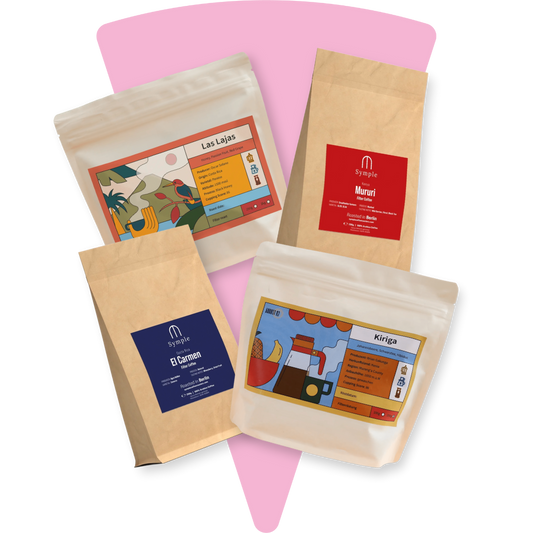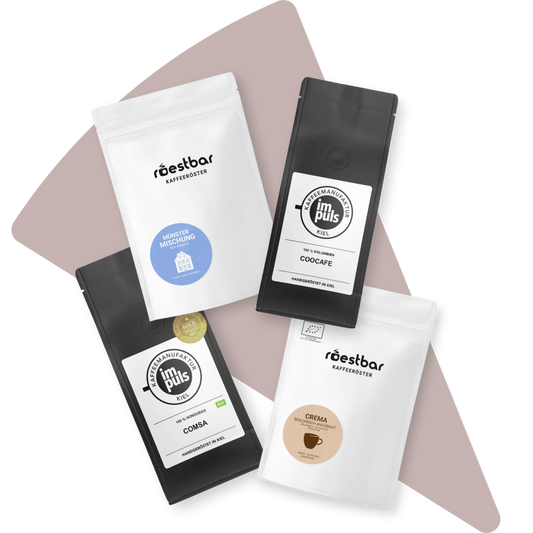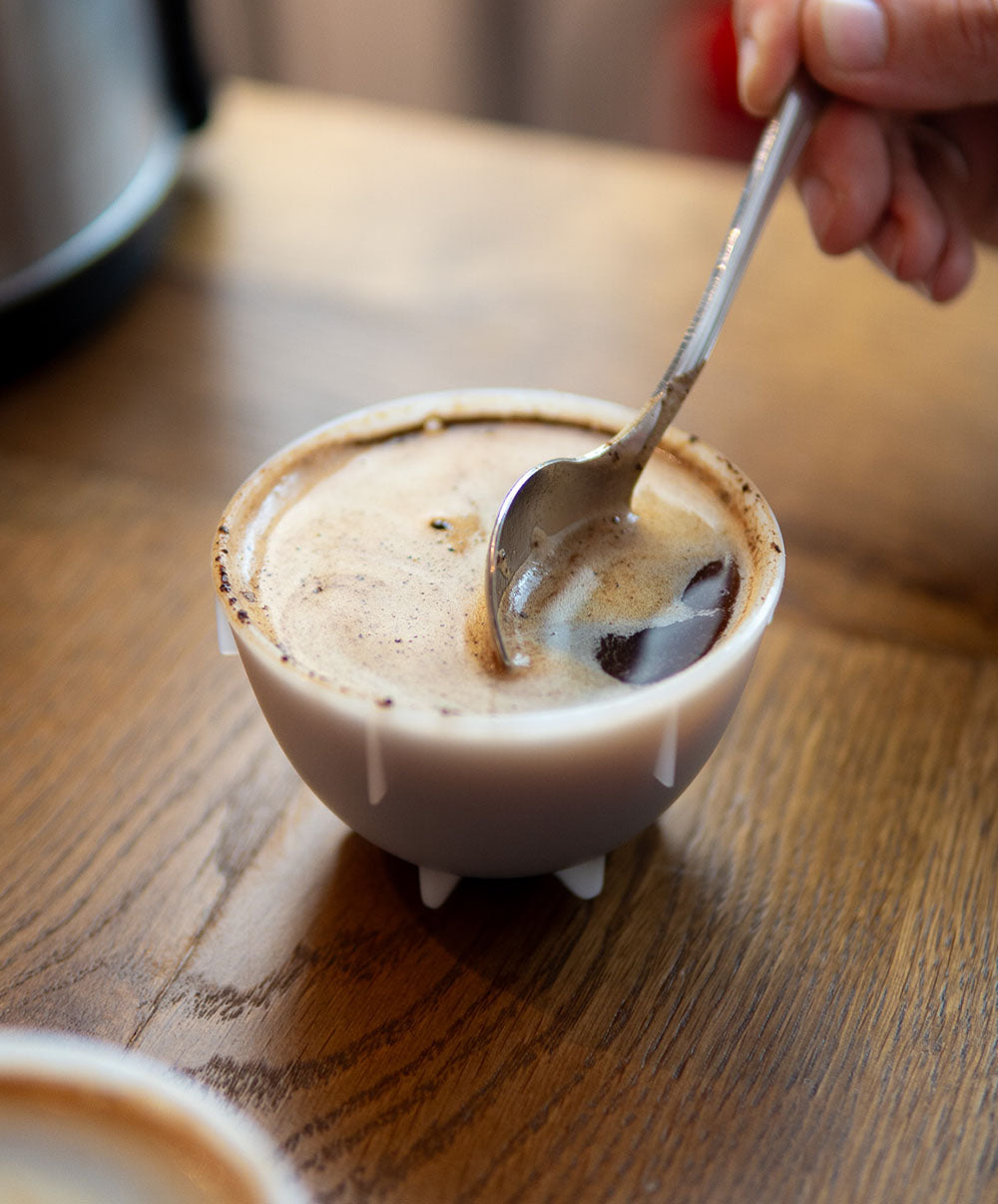
Cupping of coffee
Sweet and floral aromas as well as fruity flavors of cider, lychee and elderflower? With the so-called cupping you can taste even the finest aromas!
What is coffee cupping?
Before we dive into the details, let's first understand what coffee cupping actually is. In order to get to the bottom of these different flavors of a coffee and also to check and evaluate the quality of coffee as objectively as possible, there is the “cupping” process. It is a systematic taste test in which coffee beans are examined for their aromas , acids, body and other flavor characteristics. Similar to wine tasting, coffee cupping allows you to carefully analyze the coffee and tease out its unique characteristics.
When cupping, it is essential that all coffees are prepared with the same parameters so that the best possible comparability is possible. All coffees should be ground with the same degree of grinding and all cups should have the same ratio of coffee to water. In general, it is advisable to brew at least two cups of the same beans to ensure that one bad bean accidentally degrades the quality of the entire coffee.
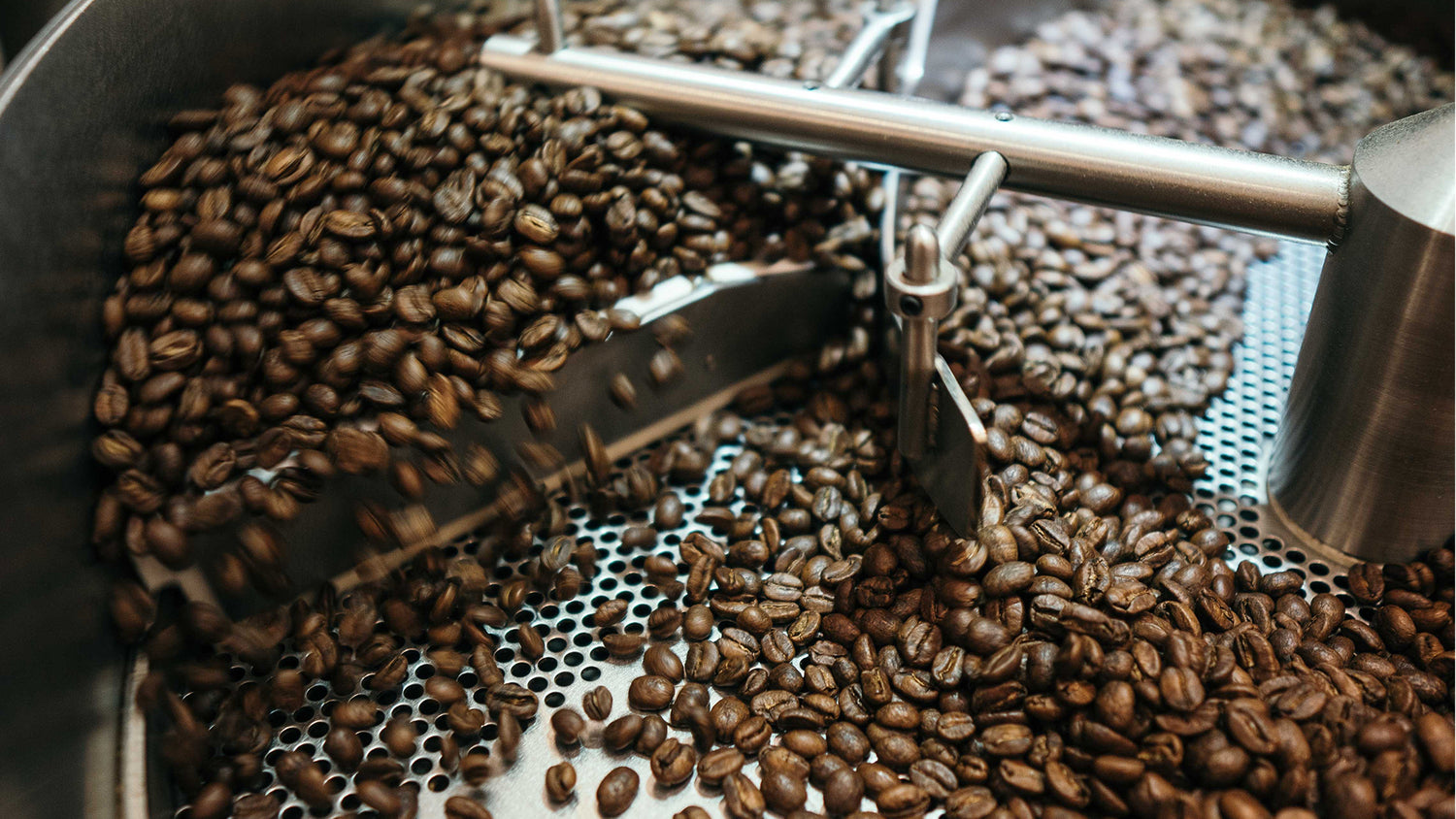
Why coffee cupping?
Cupping is not only a fun activity and trains your sensory system for different coffee flavors, but it also serves a serious purpose. Cupping allows coffee roasters and baristas to evaluate the quality of coffee beans, develop flavor profiles and even create new coffee blends. It also helps compare coffee from different regions and harvests.
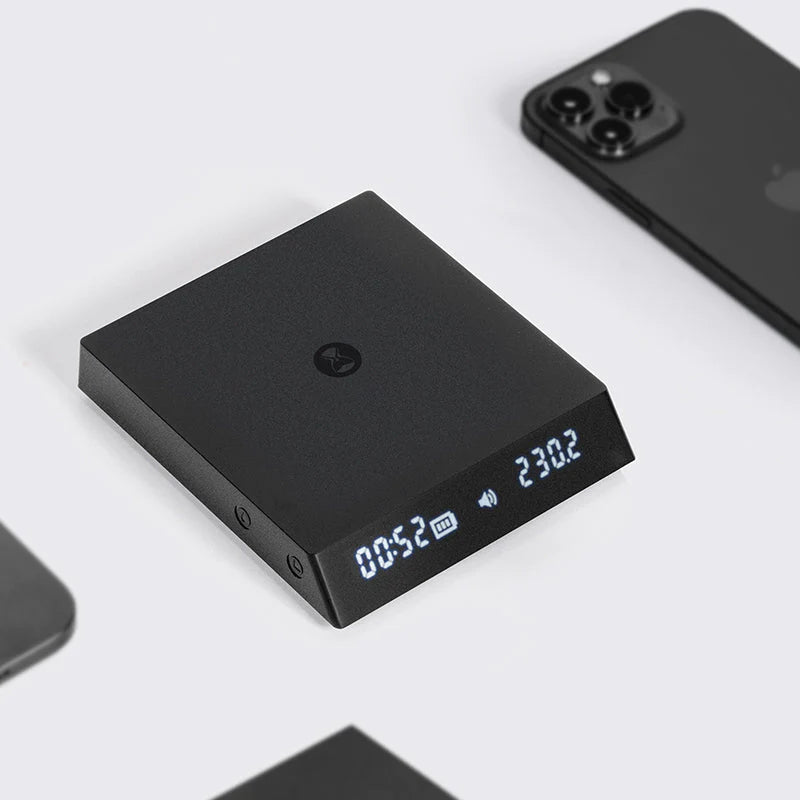
What do you need for cupping coffee?
To do coffee cupping, you don't need any special cupping accessories, just basic barista accessories :
- Kettle , scale and timer : These accessories are crucial for brewing cupping coffee, finding the right ratio between water and coffee and keeping track of the brewing time using the timer.
- A cup : The cup you use for cupping should have a capacity of around 220 ml and ideally be made of ceramic or glass.
Two cupping or tablespoons : These spoons are used to “sip” and taste the coffee from the spoon.
How does coffee cupping work?
Now that we have the equipment we need, let’s take a look at the coffee cupping process! By the way: It makes sense to compare different types of coffee. Because if you can taste the differences, it is often easier to evaluate individual coffees better.
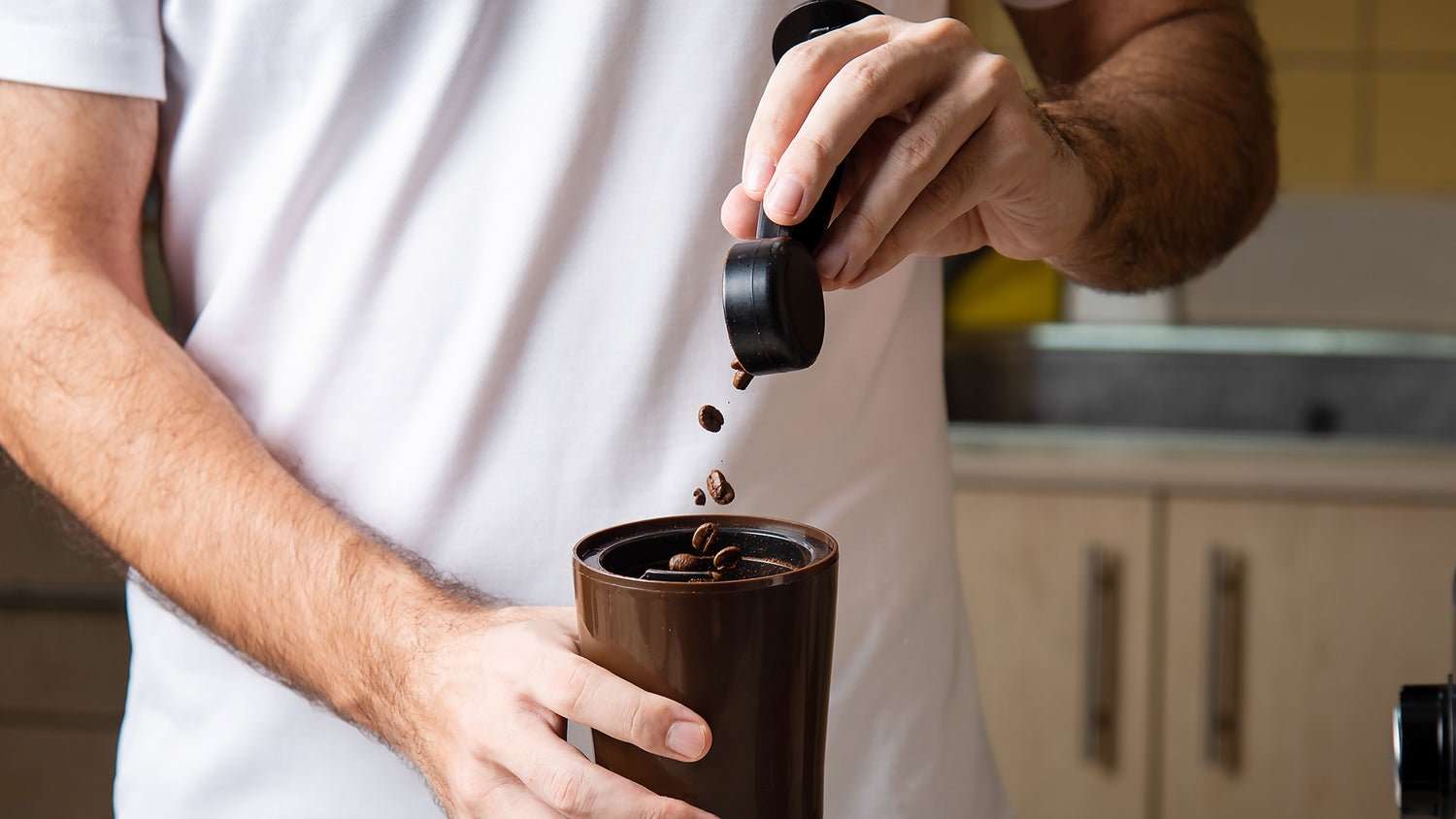
Step 1: Freshly grind coffee beans
Before you grind the coffee beans, you can first touch the dry, whole beans to get a first impression of the flavor profile.
Followed by the most important preparation step for cupping: grinding the coffee beans.
Because they should definitely end up in the cup completely freshly ground (it is best not to grind them more than 15 minutes in advance).
We grind 12 g of ground coffee, slightly coarser than the grind for the filter machine. You can also preheat the cupping cup (or cups, depending on how many samples you want to take). To do this, simply rinse them with hot water.
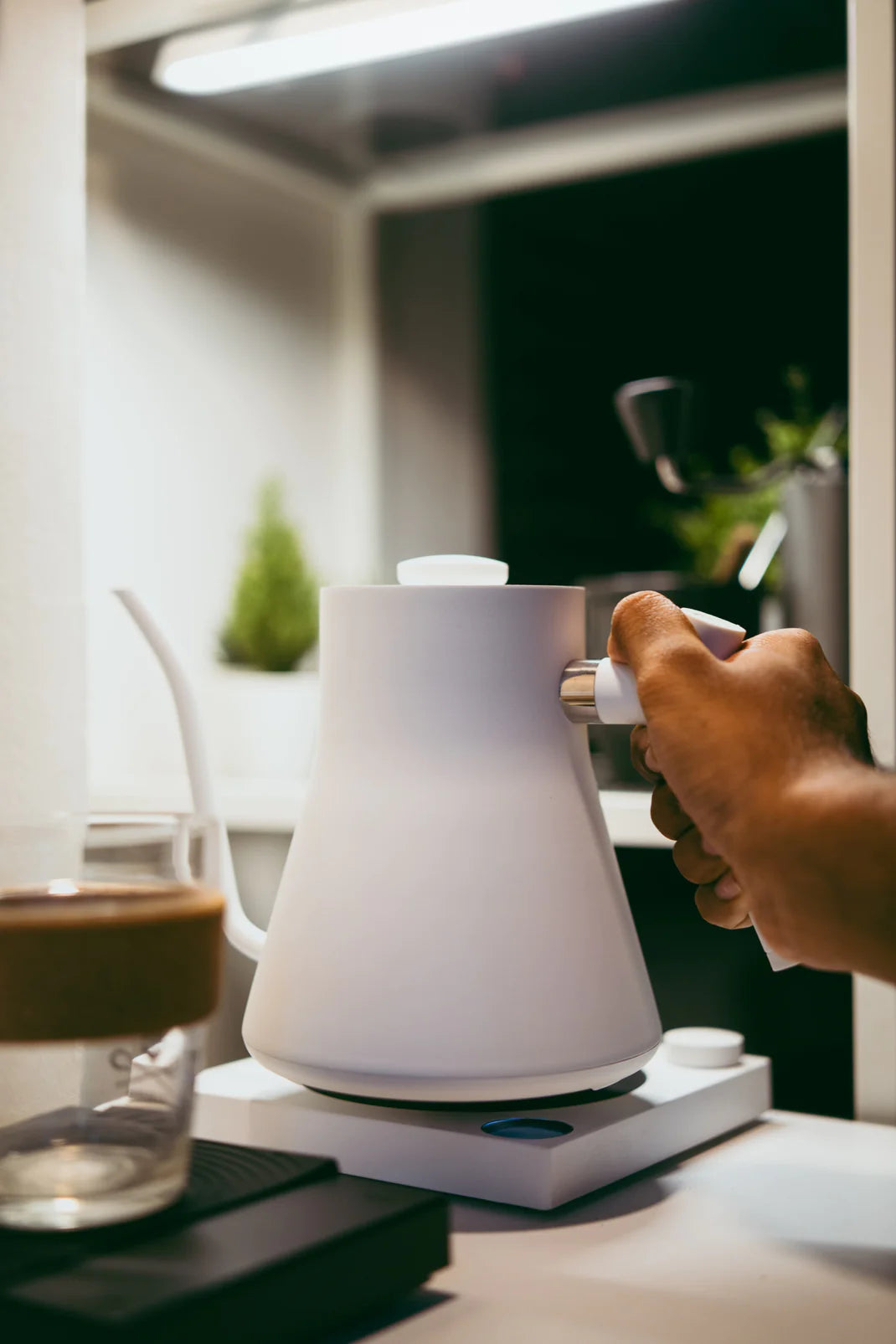
Step 2: Boil water
And to a maximum of 96 degrees. This is the optimal temperature to release all the aromas of the coffee.
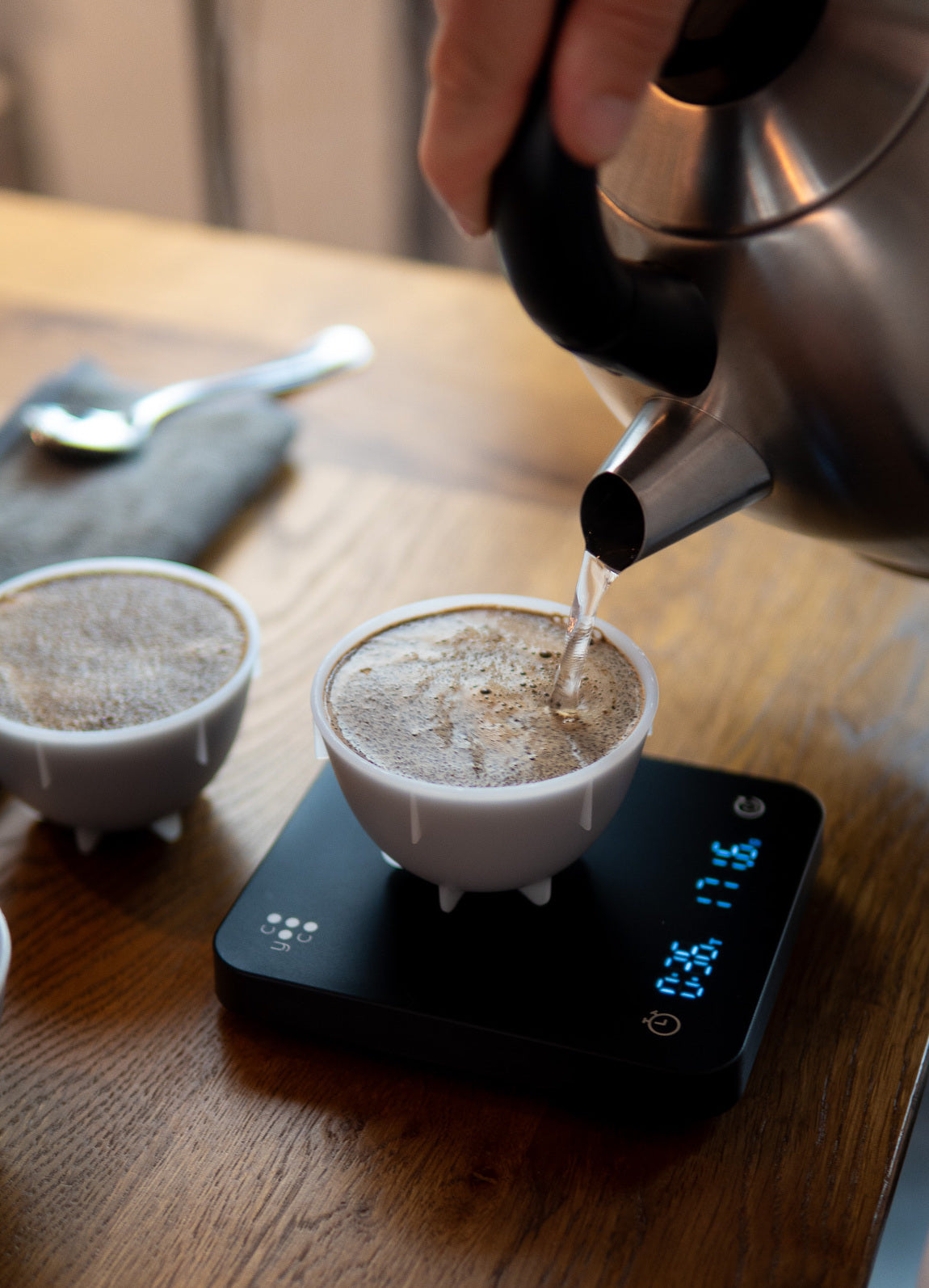
Step 3: Pour into the cup
Now carefully pour 200 ml of hot water over the coffee powder up to the edge of the cup. Try to weigh the coffee grounds and water precisely to make sure the ratio of coffee to water is just right.
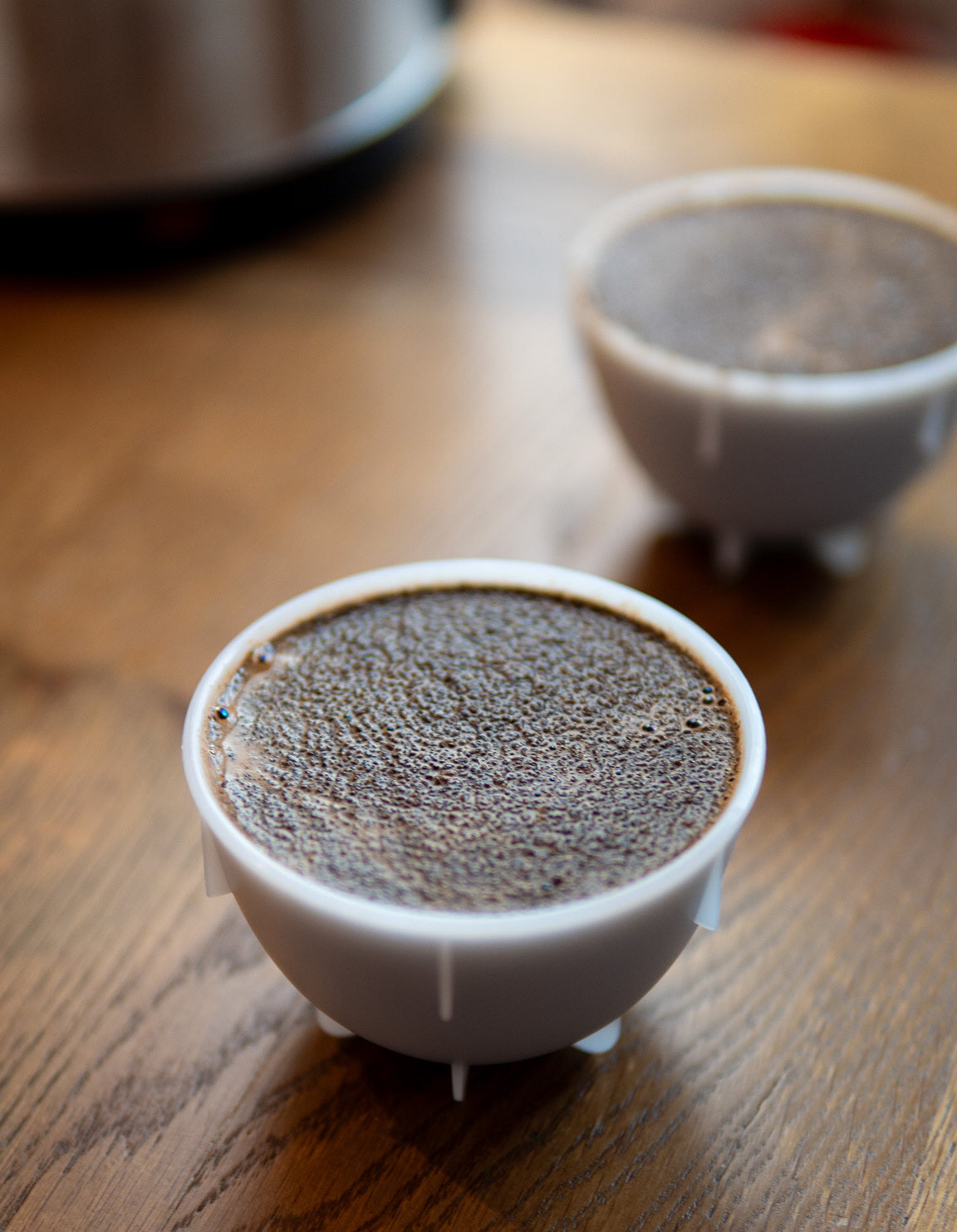
Step 4: Wait.
Let the coffee sit in the cup undisturbed for 4 minutes. During this rest period the aromas of the coffee can develop.

Step 5: Break crust.
During the 4 minute rest time a crust will form on the surface of the coffee. Now carefully break up this crust by placing the spoon in the cup.
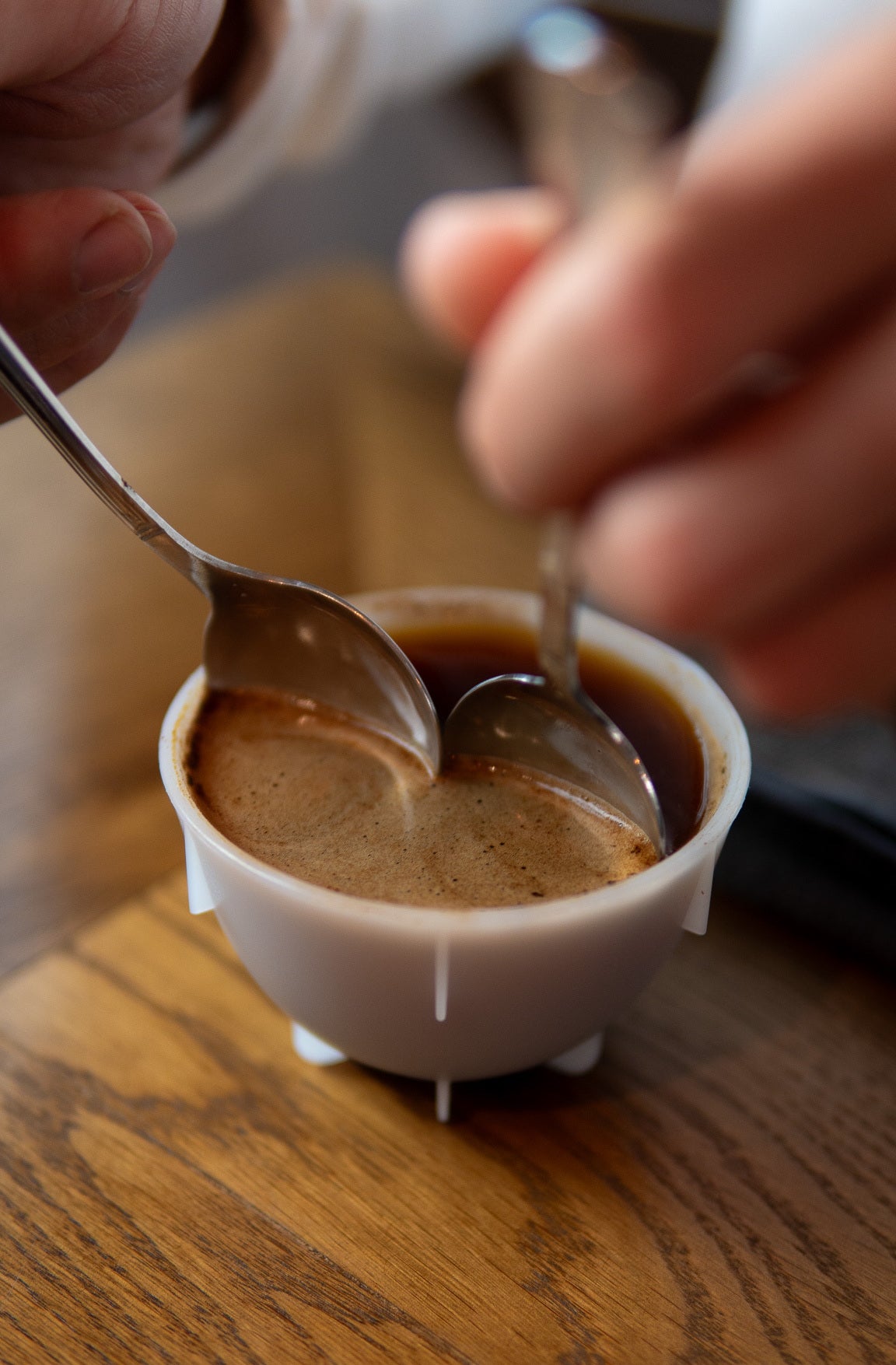
Step 6: Remove foam and excess coffee grounds.
Use your spoon to remove any remaining “foam” and coffee particles from the surface.
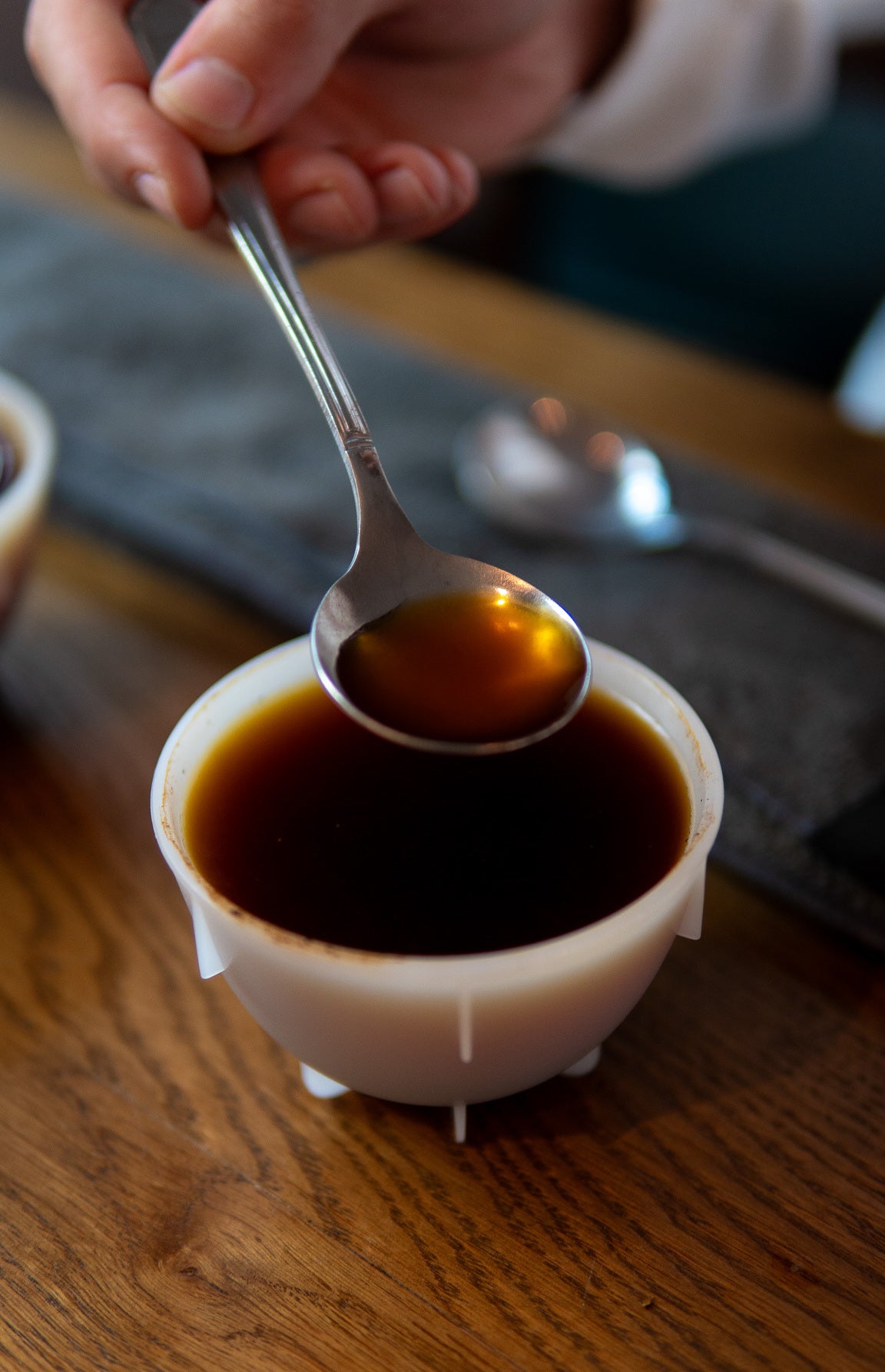
Step 8: The tasting.
Again, let the coffee sit undisturbed for 3-5 minutes. During this second resting period, any residue will settle to the bottom of the cup.
Now your cupping cup is ready for the actual cupping. To test, grab your cupping spoon or tablespoon and spoon a little liquid out of the cup. Now put your mouth to it and quickly slurp the coffee from the spoon. What do you taste?
Write down your thoughts about each of your coffees on a notepad. Possible analysis and evaluation categories are as follows: taste, aftertaste, acidity, body and balance. Sweetness, uniformity and “cleanness”.
Excursus: Sensory evaluation – what you taste when cupping coffee
The sense of taste and smell is probably the most primitive of all. We have been navigating ourselves using our senses of taste and smell since our very first days on Earth. This is how we recognized our mothers as babies. In contrast to physical senses such as touch or hearing, the senses of taste and smell function biochemically and are therefore heavily dependent on our memory.
We taste sweet, sour, bitter, salty or umami as a mouthfeel. The other sensory perceptions are different aromas. When we combine both, we have a taste in our mouths. The sense of taste is based on the gustatory system, which allows us to identify tastes through fluid stimuli. In contrast, the sense of smell relies on the olfactory system, which detects the chemical composition of airborne substances.
Aromas are very complex and are perceived through our noses and linked to our memory. What we perceive here can be divided into two groups of chemical compounds:
Volatile compounds in a gaseous state that we experience as aromas.
Non-volatile compounds that we can actually taste in our mouths using receptors.
This is also the reason why we sip coffee while cupping. This may sound and look strange to laypeople, but it makes a lot of sense. Because we want to experience both at the same time: by sipping, we allow the volatile compounds to reach our nose and evenly distribute the rest of the liquid in our mouth.
Entertainment tip for cupping coffee at home
If you want to try cupping at home: Try “blind cupping”. Here, however, you don't blindfold yourself; instead, you assign anonymous numbers to the different coffees when cupping and only later reveal which coffee is hidden behind each number. This way you can evaluate the coffees in the most objective way and test your taste buds.
Conclusion: Cupping coffee for a deeper understanding of coffee!
Coffee cupping is a playful way to experience and understand coffee in its purest form. It allows us to explore the unique flavors and nuances of coffee beans and also creates fundamental knowledge to make coffee even better.
So let’s get to it and have fun cupping your coffee!
Discover suitable coffees for cupping
-
Experimental & Complex Tasting Set Filter
(0)Kolumbien, Äthiopien, Indonesien- €68,90 / 4 x 250g
-
- €68,90 / 4 x 250g
- Unit price
- / per
- Translation missing: en.products.product.price.price_per_kg
- €68,90 / per kg | €1,10 per / Cup
New -
Floral & Light Tasting Set Filter
(0)Kenia, Kolumbien, El Salvador- €56,90 / 4 x 250g
-
- €56,90 / 4 x 250g
- Unit price
- / per
- Translation missing: en.products.product.price.price_per_kg
- €56,90 / per kg | €0,91 per / Cup
New -
Fruity & Lively Tasting Set Filter
(0)Costa Rica, Ethiopia, Kenya- €56,90 / 4 x 250g
-
- €56,90 / 4 x 250g
- Unit price
- / per
- Translation missing: en.products.product.price.price_per_kg
- €56,90 / per kg | €0,91 per / Cup
-
Nutty & Chocolaty Tasting Set Filter
(1)Mexico, Peru, Honduras, Brazil- €42,90 / 4 x 250g
-
- €42,90 / 4 x 250g
- Unit price
- / per
- Translation missing: en.products.product.price.price_per_kg
- €42,90 / per kg | €0,69 per / Cup
FAQ Cupping Coffee
frequently asked Questions
Can I try cupping coffee at home?
Sure, of course! You can find step-by-step instructions for this above. Try “blind cupping”. Here, however, you don't blindfold yourself; instead, you assign anonymous numbers to the different coffees during cupping and only later reveal which coffee is hidden behind each number. This way you can Evaluate coffees in the most objective way and test your taste buds.
Why should I cup coffee?
Cupping is not only a fun activity but also serves a serious purpose. It allows coffee roasters and baristas to evaluate the quality of coffee beans, develop flavor profiles and even create new coffee blends. It also helps to compare coffees from different regions and harvests and to develop a deeper understanding of coffee.
Is there a recommended temperature for cupping water?
Yes, the recommended water temperature for cupping is a maximum of 96 degrees Celsius. This temperature allows the aromas of the coffee to be optimally released.
Which coffee beans are best for cupping?
It's best to use high-quality single-origin coffee beans for cupping as they offer a wide range of flavor profiles.
Why do you sip coffee while cupping?
The purpose of sipping is to bring the volatile compounds to your nose while simultaneously distributing the coffee evenly across your mouth. This allows you to better perceive both the aromas and taste of the coffee.
How can I improve my cupping skills?
Improving your cupping skills takes practice and patience. You can also attend training courses and workshops to deepen your understanding.
Can I compare different types of coffee when cupping coffee?
Yes, cupping is a great way to compare different types of coffee. If you can taste differences, it is often easier to better evaluate individual coffees and discover your preferences.
More coffee knowledge
View all-
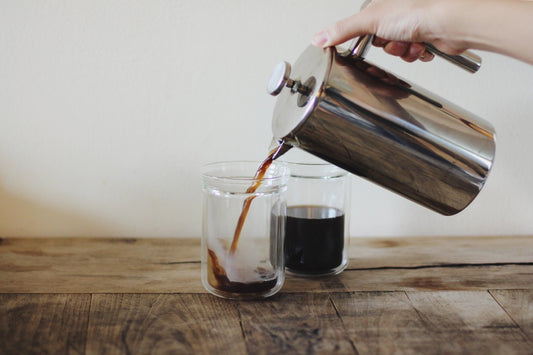
Cleaning a Coffee Pot: A Guide to Proper Care
Whether it's coarse dirt or light dirt - with our guide you'll be able to clean your coffee pot in no time. Also find out how you can avoid pollution...
Cleaning a Coffee Pot: A Guide to Proper Care
Whether it's coarse dirt or light dirt - with our guide you'll be able to clean your coffee pot in no time. Also find out how you can avoid pollution...
-
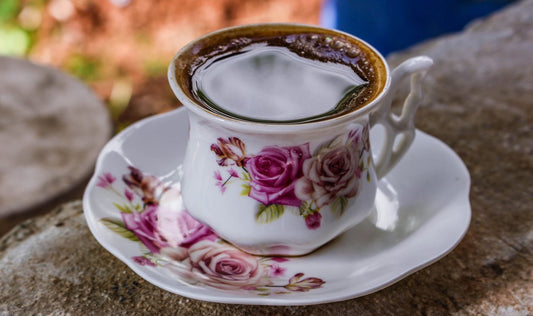
Flower coffee: what does the term mean?
Floral coffee? What should it be? If you have just asked yourself this question, you should read this article. Because perhaps you have already prepared it yourself unknowingly.
Flower coffee: what does the term mean?
Floral coffee? What should it be? If you have just asked yourself this question, you should read this article. Because perhaps you have already prepared it yourself unknowingly.
-
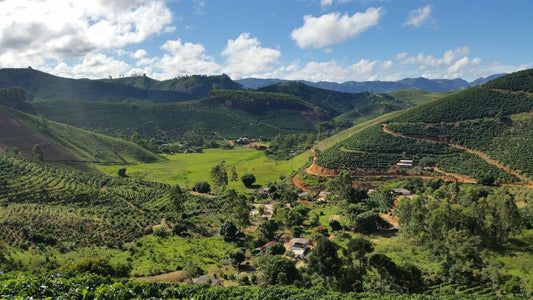
Growing Coffee: From Plant to Cup
Immerse yourself in the fascinating world of growing coffee! In this article, you'll learn how coffee grows, what techniques are needed to harvest perfect coffee beans, and what developments are...
Growing Coffee: From Plant to Cup
Immerse yourself in the fascinating world of growing coffee! In this article, you'll learn how coffee grows, what techniques are needed to harvest perfect coffee beans, and what developments are...

